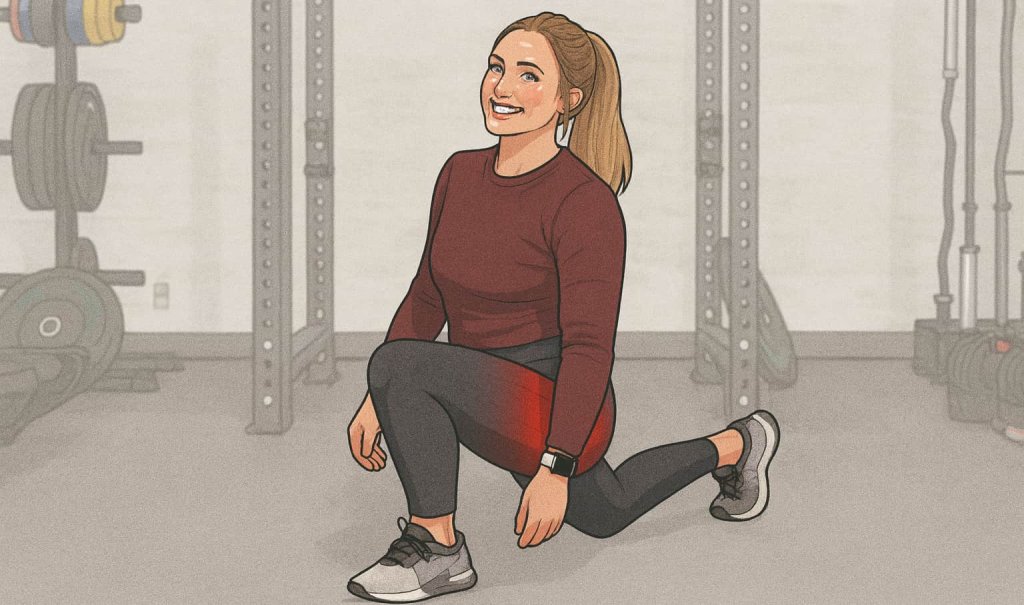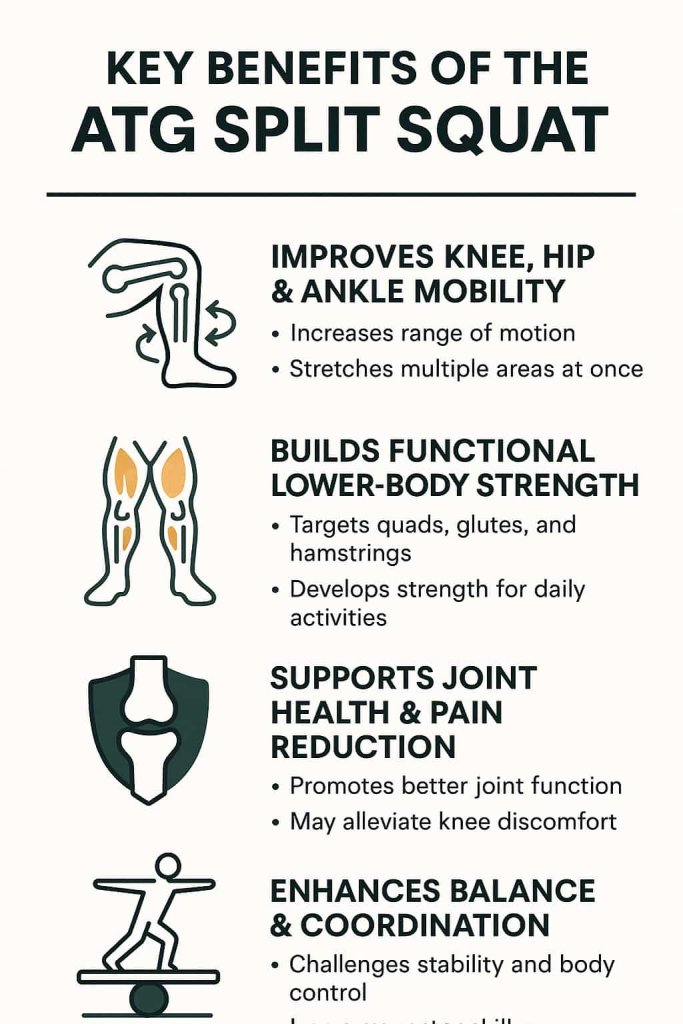The ATG (Ass-to-Grass) Split Squat is one of the most effective lower-body exercises for improving joint health, mobility, and strength.
By lowering “ass-to-grass” in a split stance until your hamstring touches your calf, you open up your hips, strengthen your knees, and improve ankle mobility — all while building serious leg and core strength.

If you want better flexibility, pain-free knees, and balanced leg power, the ATG Split Squat should be in your training plan. This guide covers the benefits, form, programming tips, and mistakes to avoid so you can master it safely and effectively.
What Is the ATG Split Squat?
The ATG (Ass-to-Grass) Split Squat is a unilateral lower-body exercise where one foot is placed in front and the other behind. The goal is to descend deeply, letting the front hamstring touch the calf while keeping the heel grounded.
It’s been popularized by Ben Patrick (Knees Over Toes Guy) and praised for its ability to rehab knees, improve mobility, and enhance athletic performance.
Key Benefits of the ATG Split Squat

1. Improves Knee, Hip, and Ankle Mobility
By working through a deep range of motion, the ATG Split Squat stretches and strengthens the muscles and connective tissues around your joints.
- Boosts ankle dorsiflexion (helpful for squats and running)
- Increases hip flexor length and reduces stiffness
- Encourages pain-free knee tracking over the toes
2. Builds Functional Lower-Body Strength
This move targets:
- Quads – especially the vastus medialis oblique (VMO), key for knee stability
- Glutes – for power and hip extension
- Hamstrings & adductors – for stability and control
- Core muscles – to keep you upright under load
The unilateral nature corrects muscle imbalances and improves athletic performance.
3. Supports Joint Health and Pain Reduction
Controlled forward knee travel strengthens tendons, ligaments, and joint structures — potentially reducing knee discomfort over time.
Athletes recovering from patellar tendinitis or stiffness often find relief when this exercise is performed correctly.
4. Enhances Balance and Coordination
Because it challenges one leg at a time, you’ll build better balance, proprioception, and stability — all crucial for sports, running, and daily life.
How to Perform the ATG Split Squat (Step-by-Step)
Set up your stance
- Place your front foot flat on the floor, back foot behind you (ball of the foot down).
- Keep hips square and shoulders upright.
Descend slowly
- Bend your front knee forward, letting it travel past your toes.
- Keep your front heel down.
- Lower until your hamstring lightly touches your calf.
Maintain form
- Core braced, chest up, spine neutral.
- 90% of weight on the front leg.
Drive up
- Push through the front heel to return to the start position.
Pro Tips:
- Use a slant board for extra ankle mobility.
- Start with bodyweight before progressing to dumbbells or barbells.
- Pause briefly at the bottom to build strength in your weakest range.
Programming Guidelines
| Goal | Sets/Reps | Load Type | Frequency |
|---|---|---|---|
| Mobility & Rehab | 2–3 sets × 10–15 reps | Bodyweight/light load | 2–3×/week |
| Strength | 3–5 sets × 5–8 reps | Moderate to heavy load | 1–2×/week |
| Hypertrophy | 3–4 sets × 8–12 reps | Moderate load | 2×/week |
Common Mistakes to Avoid
- Shallow depth – limits mobility and strength benefits
- Leaning too far forward – strains the lower back
- Losing heel contact – reduces knee and ankle activation
- Rushing reps – prevents proper control and muscle engagement
ATG Split Squat Variations
1. Dumbbell ATG Split Squat
Holding a dumbbell in each hand allows greater freedom of movement compared to a barbell, making it easier to find your natural range without shoulder strain.
- Why it works: Dumbbells provide a more natural grip and let your arms hang by your sides, reducing pressure on your spine and shoulders.
- How to do it:
- Hold a dumbbell in each hand at your sides.
- Step into a split stance, back heel off the floor.
- Lower yourself slowly until your back knee lightly touches the ground, keeping your front shin vertical.
- Push through your front heel to return to the starting position.
- Trainer Tip: Keep your torso upright for more quad emphasis, or lean slightly forward to target the glutes and hamstrings.
2. Front-Foot Elevated ATG Split Squat
Placing your front foot on a low platform or bumper plate increases your range of motion and boosts glute activation.
- Why it works: Elevation lets your knee travel further forward while maintaining balance, which stretches the quads and activates the glutes more effectively.
- How to do it:
- Place your front foot on a 2–4 inch platform.
- Step your back leg into position, keeping your torso upright.
- Lower until your back knee lightly touches the ground and your front knee passes slightly over your toes.
- Drive up through your front heel.
- Trainer Tip: Start with bodyweight to master balance before adding load.
3. Barbell ATG Split Squat
The heaviest loading option for serious strength gains, ideal for experienced lifters with good balance.
- Why it works: The barbell lets you load heavier than dumbbells, increasing overall strength stimulus for the quads, glutes, and hamstrings.
- How to do it:
- Set a barbell on your upper traps like in a back squat.
- Step forward into a split stance.
- Lower under control until your back knee grazes the floor, keeping your torso upright.
- Push back up without locking out the front knee fully.
- Trainer Tip: Use safety pins in a squat rack if lifting heavy, and ensure your core is braced to protect your lower back.
4. Assisted ATG Split Squat
Perfect for beginners, rehab, or stability work, this variation uses a support like a TRX strap, pole, or railing.
- Why it works: Reduces the balance challenge so you can focus on proper depth, posture, and joint mobility.
- How to do it:
- Hold onto a stable support with one or both hands.
- Step into a split stance.
- Slowly descend into a deep split squat, letting the support assist you.
- Push back up, keeping pressure light on the support.
- Trainer Tip: Gradually reduce reliance on the support over time to build balance and stability.
Frequently Asked Questions
1. Is the ATG Split Squat safe for bad knees?
Yes — when performed correctly, it strengthens knee-supporting muscles and connective tissue.
2. Should my knee go past my toes?
Yes — controlled forward knee travel is encouraged for full ankle and quad activation.
3. How low should I go?
Aim for hamstring-to-calf contact without losing form.
4. Can I load this exercise heavily?
Yes, but only after mastering bodyweight form and mobility.
5. Do I need special equipment?
No — but wedges, slant boards, or lifting shoes can help achieve depth.
6. Is it better than lunges?
They’re different: lunges are dynamic, while ATG Split Squats are static and mobility-focused.
Conclusion
The ATG Split Squat is more than a leg exercise — it’s a mobility, strength, and joint-health powerhouse. By training through full range, you’ll unlock stronger, more flexible knees, hips, and ankles, while building balance and functional power.
